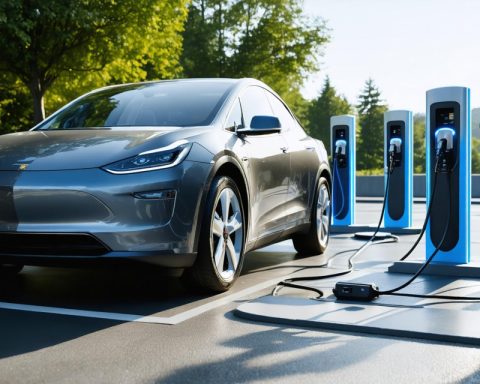- India is engaging in transformative negotiations with the United States to address tariff tensions and establish a new bilateral trade agreement.
- India announced the removal of import duties on key components for EV batteries and mobile phones, enhancing domestic manufacturing and export competitiveness.
- This tariff reduction targets 35 items for EV production and 28 for mobile phones, representing a strategic move to boost these sectors.
- The negotiations aim to mitigate potential retaliatory tariffs from the U.S., fostering economic stability and mutual growth.
- India shows readiness to lower tariffs on approximately $23 billion worth of U.S. imports, seeking a phased trade deal with the United States.
- This initiative highlights the importance of bilateral economic dialogue and the role of trade agreements in navigating globalization and technological change.
In a strategic pivot that could reshape the economic landscape, India has set the stage for transformative negotiations with the United States, aiming to resolve simmering tariff tensions and forge a new bilateral trade pact. As international negotiations intensify, India made a bold move: announcing the removal of import duties on a swathe of critical components essential for manufacturing electric vehicle (EV) batteries and mobile phones. This decision, as declared by Finance Minister Nirmala Sitharaman, signals a decisive step toward boosting domestic manufacturing and enhancing export competitiveness.
Imagine a bustling factory floor, where raw materials once snagged by restrictive tariffs now flow unimpeded, fueling a new era of production efficiency. India has targeted 35 items for EV battery production and 28 for mobile phones, slashing import duties in a clear directive to turbocharge these rapidly evolving sectors. This initiative stands not just as a logistical shift, but as a visionary stance in a world increasingly defined by technology and sustainability.
Behind this bold policy lies a drama of international diplomacy as India’s government seeks to counterbalance potential retaliatory tariffs from the United States under President Donald Trump’s administration. These tariffs, set to take effect on April 2, cast long shadows over economic forecasts, stoking fears of disruption. Yet, in the midst of this challenge lies opportunity. The ongoing negotiations between the two democratic giants are not a mere exchange of figures, but a crucial dialogue with the potential to cement economic stability and foster mutual growth.
The heart of these talks beats with shared interests, as India signals not just a willingness, but an eagerness, to lower tariffs on a significant portion of U.S. imports, valued at around $23 billion. Such gestures illustrate the broader vision: a phased trade deal that could solidify a more resilient commercial bridge across the Pacific.
Picture Indian and American officials huddled in conference rooms, each side striving to protect domestic interests while unlocking new avenues for exchange and prosperity. Their efforts to craft a revised trade framework reflect an understanding that the global economic order hinges increasingly on such bilateral conversations.
This diplomatic dance is not merely about averting economic conflict; it’s about embracing the future. As nations grapple with the twin challenges of globalization and technological transformation, India’s strategic tariff recalibration offers a roadmap. The message is clear: By adapting to the evolving economic landscape and nurturing domestic innovation, countries can rise above conflict and competition.
As the world’s largest democracies carve out this new chapter, their trajectory could very well become a blueprint for others to follow. The discussions may be complex and the path forward dotted with challenges, but at its core, this endeavor encapsulates a universal truth: Collaboration and forward-thinking are the true drivers of progress.
India’s Bold Trade Strategy: Will it Reshape Global Economics?
Overview
In a groundbreaking move poised to reshape global trade dynamics, India has strategically initiated negotiations with the United States to address ongoing tariff tensions. This initiative aims to craft a new bilateral trade agreement that could significantly influence the economic landscape. Key to this strategy is India’s decision to eliminate import duties on vital components used in electric vehicle (EV) battery and mobile phone manufacturing, as announced by Finance Minister Nirmala Sitharaman. This initiative is designed to stimulate domestic production and boost export competitiveness.
Insights into India’s Strategic Tariff Cuts
India’s decision to target 35 components for EV batteries and 28 for mobile phone manufacturing by reducing tariffs marks a substantial shift towards enhancing productivity in these burgeoning sectors. This policy not only aims to streamline production processes but also underscores India’s commitment to technological and sustainable advancement.
Benefits of Removing Import Duties
1. Boosted Domestic Manufacturing: By eliminating import duties on crucial components, India aims to catalyze domestic manufacturing. This move could lead to increased production efficiency and lower costs for manufacturers, positioning India as a competitive actor in the global market.
2. Enhanced Export Competitiveness: With reduced production costs, Indian manufacturers could offer competitive pricing on the international stage, potentially increasing exports.
3. Encouragement for Innovation: By providing easier access to high-quality components, India supports innovation in EV and mobile manufacturing sectors, fostering technological advancements.
4. Sustainability Goals: Aligning with global sustainability trends, India’s focus on EV components signals a shift towards greener energy and sustainable transportation solutions.
How-To Steps for Maximizing Benefits
To fully capitalize on these tariff cuts, manufacturers can take the following steps:
1. Optimize Supply Chains: Source high-quality components swiftly and integrate them within production lines to enhance efficiency.
2. Enhance R&D: Invest in research and development to create cutting-edge, sustainable products that meet international standards.
3. Leverage Government Incentives: Stay informed about government initiatives and potential subsidies aimed at fostering innovation in the EV and mobile sectors.
Real-World Use Cases
Countries looking for blueprints to facilitate their own manufacturing ecosystems can look at India’s approach as a model for striking a balance between protecting local industries and inviting foreign partnerships.
Potential Concerns and Limitations
While these trade negotiations unfold, consider these potential challenges:
– International Retaliation: The risk of retaliatory tariffs from the U.S. could present substantial hurdles and geopolitical tensions that might disrupt economic harmony.
– Implementation Delays: Bureaucratic obstacles and policy implementation delays could hinder immediate benefits from the tariff cuts.
Market Forecasts & Industry Trends
As a rapidly emerging market for EVs and mobile technologies, India is positioned at a pivotal point. Deloitte projects growth in India’s EV market, driven by policy support, consumer demand, and advancements in technology. The trade agreement could act as a catalyst, accelerating these trends.
Actionable Recommendations
1. Monitor Negotiations: Businesses should closely monitor the progress of trade negotiations to anticipate changes and align their strategies accordingly.
2. Diversify Supply Chains: In preparation for potential shifts, explore diverse supply sources to mitigate risks of dependency on single markets.
3. Invest in Local Talent: Train and develop a skilled workforce to improve productivity and innovation within the domestic manufacturing scene.
Conclusion
India’s strategic removal of import duties represents a visionary pivot towards enhancing global trade relations while bolstering domestic manufacturing. By fostering innovation and strategic alliances, India sets a precedent for balancing globalization with local economic interests.
For more insights on international trade and economic strategies, visit the World Economic Forum.














